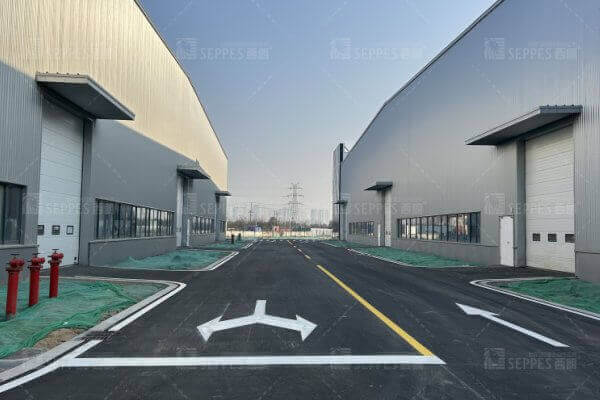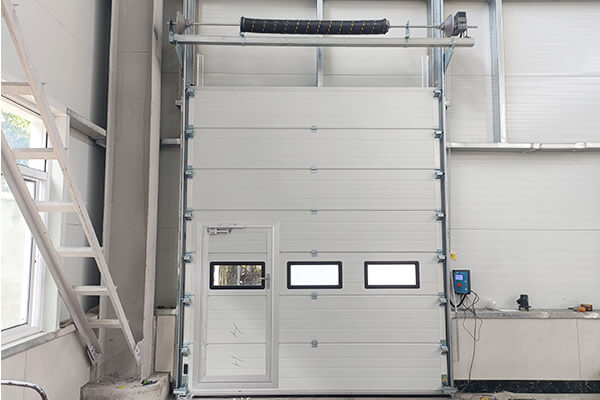
Warehouse Door Types Explained: Which One Is Right for Your Facility?
In the modern logistics and warehousing industry, warehouses are important places for storing goods and items. Warehouse door serves as an important medium to connect the interior and exterior of the warehouse. More than just an access point, warehouse doors have a direct impact on the efficiency, safety, and energy management of warehouse operations.
If you run a commercial warehouse, distribution center, manufacturing plant, or retail store, you know how important it is to ensure the safe and efficient transfer of goods from one place to another. That’s why choosing the best warehouse doors is so important. Here’s what you need to know about the types of warehouse doors and advice on choosing the right one.

Common Types of Warehouse Doors
Choosing the right type of warehouse door can improve operational efficiency and reduce costs. Here are different types of warehouse doors with unique benefits and usage scenarios to help you choose the right door for your warehouse.
High speed door

High speed doors are ideal for industrial and commercial facilities that require frequent access and fast opening and closing of warehouses. In warehousing operations, fast and easy access to goods is the key to ensuring a smooth logistics process. seppes brand high speed roll up doors open at speeds of up to 1.5m/s, can be opened in a very short time and operate reliably throughout the year. Its efficient, safe and reliable performance meets the needs of the logistics and warehousing industry.
Sectional door

En puerta seccional is a burglar-proof door for industrial plants, warehouses and loading docks. Commercial sectional doors consist of a number of independent panels, which are raised below the ceiling by means of a slide and spring system. It is different from other industrial doors, such as PVC fast doors and stacking high speed doors, in that it is made of colored steel panels with high thermal insulation polyurethane foam inside, which makes it a very strong anti-theft system, with higher sealing and safety performance.
Advantages
Space-saving: the sectional door slides upward when it opens and does not occupy the space outside or inside the door, suitable for warehouses with limited space.
Thermal insulation: due to the multi-layer structure, sectional door has a good thermal insulation effect and is suitable for temperature-controlled warehouses or cold storage.
High security: the sturdy panel and closure design provides high security against external intrusion.
Applicable Scenarios: Suitable for medium to large warehouses, industrial plants and places that require a high level of security and thermal insulation.
Warehouse roll up door

Warehouse roll up doors are one of the most popular warehouse doors for warehouses and other commercial facilities. These doors are made of aluminum alloy or steel with a roll up system to roll up the curtain. They are characterized by low noise, no rust, and high quality aesthetics.
Advantages
Small footprint: since the warehouse door rolls up the curtain, it takes up less space and is suitable for places with limited space.
High adaptability: suitable for different climatic conditions, providing windproof and rainproof functions.
Low maintenance cost: simple structure, easy to maintain and repair
Warehouse sliding door

Warehouse sliding doors open by sliding horizontally and are generally composed of a track and roller system. Unlike traditional opening and closing doors, sliding doors are suitable for areas with wider spaces.
Advantages
Suitable for large spaces: sliding doors do not require additional opening and closing space and are suitable for warehouses with large door widths, especially for the access of large goods or equipment.
Sturdy and durable: sliding doors are mostly made of metal, able to withstand heavy loads and are more durable.
Warehouse dock door

Warehouse dock doors are designed for warehouse loading docks and are often used in conjunction with loading docks to facilitate access to goods. They are usually of sturdy construction and can withstand the impact of heavy loads.
Advantages
Suitable for large spaces: warehouse loading dock doors do not require additional opening and closing spaces and are suitable for warehouses with large door widths, especially for the access of large goods or equipment.
Sturdy and durable: Dock doors are mostly made of metal materials, which can withstand heavy loads and are more durable.
Suitable for high-frequency use: suitable for places that require frequent access, such as high-traffic terminals and logistics centers.
How to Choose the Right Warehouse Door for Your Facility
Choosing the right warehouse door is the key to optimizing warehouse operations, increasing efficiency and saving energy. The type of warehouse door depends not only on the size of the warehouse, but also closely related to the flow demand, temperature control requirements and other working environment factors.
Selection of door type according to warehouse size
The size of the warehouse has a direct impact on the choice of door. Small warehouses and large warehouses, the difference between the needs of j larger, such as in the flow. The door frequency of use and the required security and functionality.
Small warehouse vs Large warehouse
For small warehouses, doors that open frequently are usually not needed. Warehouse roll-up doors can fulfill the need. These doors are less costly, easy to install, and suitable for low-traffic environments.
Large warehouses usually have a higher traffic demand. The door is also used more frequently, so you need to quickly open and close the door. At this time, warehouse roll up doors and high speed rolling door is a more appropriate choice.
High-traffic areas vs Low-traffic areas
In high-traffic areas, doors need to open quickly and close quickly to avoid traffic delays and unnecessary energy loss. High-speed rolling doors are ideal, as they can open and close quickly and effectively reduce the impact of external temperatures on the internal environment of the warehouse.
For low-traffic areas, where doors are opened less frequently, manual or automatic doors can meet the demand and are usually less costly. Manual roll-up and sliding doors are particularly suitable in these areas.
According to the working environment
The working environment of the warehouse is crucial in choosing the right type of door. Different temperature control needs and environmental conditions determine the functional requirements of the door. The choice should be based on the specific needs of the most appropriate product.
Temperature-controlled warehouses
Temperature-controlled warehouses usually need to maintain a certain temperature range, such as pharmaceutical warehouses, food warehouses and so on. In such environments, the insulating properties of the door are very important. The type of door suitable for temperature-controlled warehouses should have good sealing and insulation to ensure stable internal temperatures and reduce energy consumption.
Refrigerated/freezer warehouses
For refrigerated and frozen warehouses, door sealing and energy efficiency are critical. A quality sealing design ensures that the internal temperature of a temperature-controlled warehouse is not affected by the external environment. Thus reducing energy consumption and ensuring the quality of goods. Refrigerated warehouse doors should be efficiently insulated and sealed to meet the challenges of prolonged cold temperatures.

Installation and Maintenance Tips for Warehouse Doors
Correct installation
Correct installation is carried out according to the drawings in order to avoid installation errors. It also ensures optimal performance of the door, increasing its energy efficiency and longevity.
Routine maintenance
Regular maintenance is essential to ensure that your warehouse doors remain operational. Lubricate moving parts, check seals for wear, and inspect sensors or automated systems regularly to prevent downtime.
Troubleshooting common Issues
Common issues include broken springs, malfunctioning sensors, or door misalignment. Regular inspection and timely repairs will reduce costly emergency fixes and keep operations running smoothly.
Conclusión
Choosing the right warehouse door is a critical decision that affects efficiency, security, and energy costs. By considering factors such as traffic volume, energy efficiency, environmental conditions, and security, you can select the ideal door for your facility. Whether you need high-speed roll-up doors for quick access or sectional doors for better insulation. The right warehouse door can significantly improve your operations.



